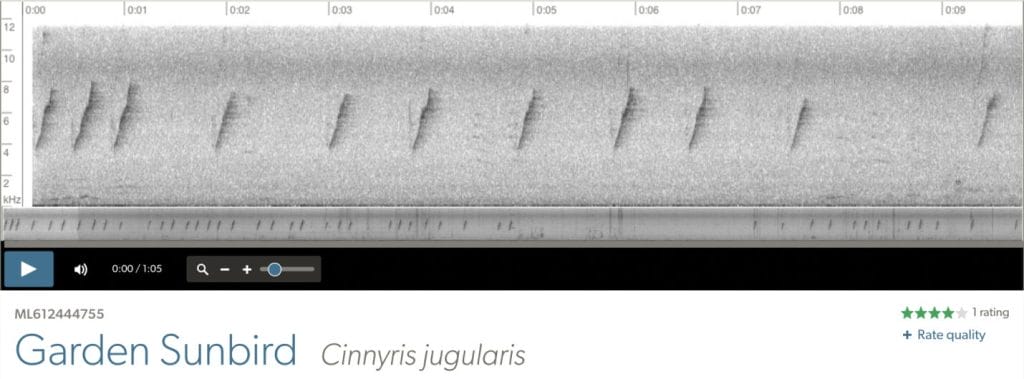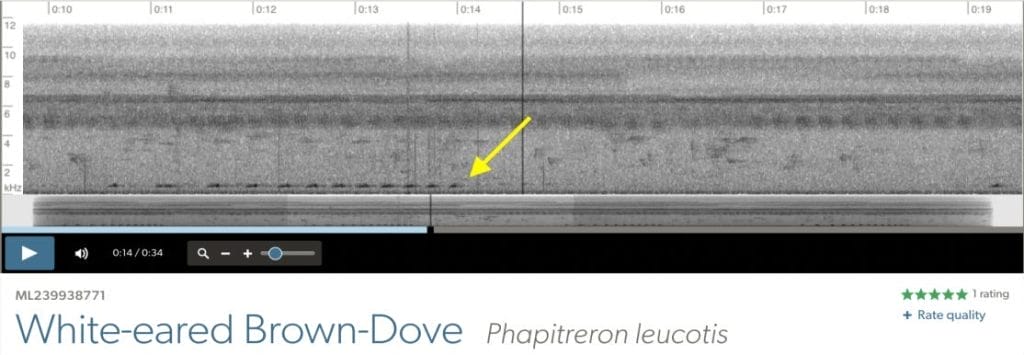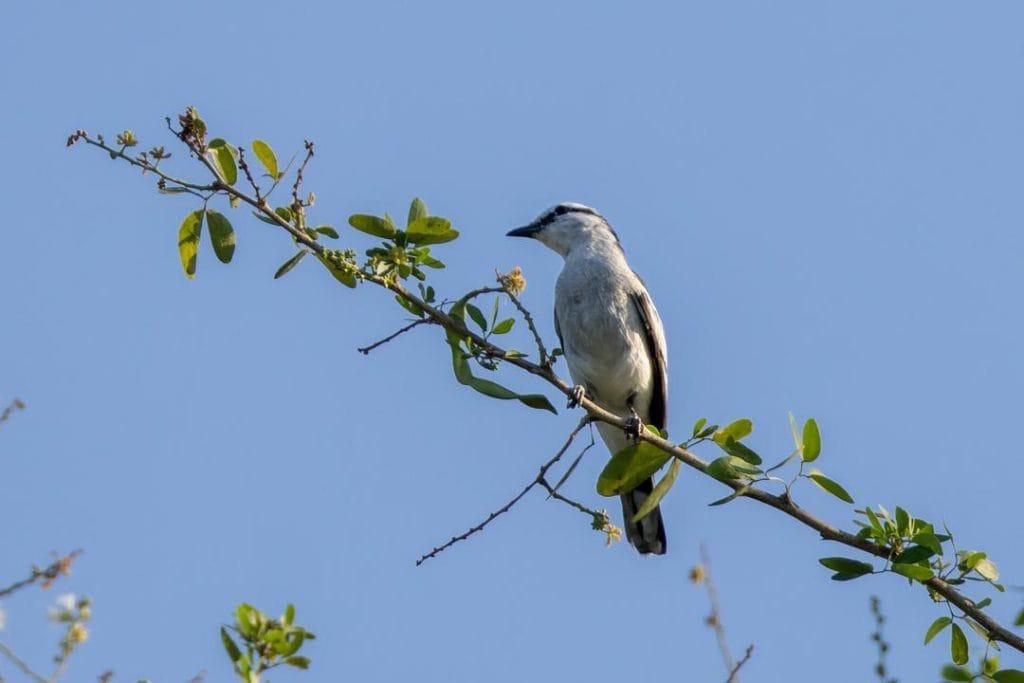By Janina Castro
“Ano yun?! Yung matinis na call diyan sa taas!” (What’s that?! The shrill call up there!)
“No no no it’s the far away that sounds like a frog!”
“‘Di ba yung oriole parang piiiiiyew?” (Doesn’t the call of the oriole go piiiiiyew?)
“Yun yung melodious na song! Ay… Elegant Tit nanaman…” (That’s the melodious song! Aww… It’s just an Elegant Tit again…)
I’m sure we’ve all heard discussions like this when out birding. In the field, it can be really tricky to describe what we hear. Field notes and onomatopoeia can be pretty subjective, making it difficult to articulate what was heard. How can you describe the difference between the tsee tsee of a Red-keeled Flowerpecker and the tsweet tsweet of a Garden Sunbird? Or the deep hooting of a White-eared Brown Dove versus a Philippine Coucal? Recording the sounds and checking out the spectrogram is one way to see the sounds and visually compare calls.
Note that the technical term “call” and “song” are specific depending on the complexity. For this article, I used the terms interchangeably.
Turning sound into pictures
A spectrogram is a graph that helps visualize signals (in this case sounds) over a period of time. Check out the example below using the call of a Black-naped Monarch from the Macaulay Library. It can be a bit daunting with all of the information but the basics are:
- The horizontal axes refers to time (here it’s in seconds)
- Darker colors (or in some software, brighter colors) are louder. Lighter colors indicate softer sounds.
- The higher up in the image, the higher the pitch (typically written in kHz or kiloHertz).

Link to basic parts of a spectrogram for a: Black-naped Monarch

Opening the recording on a music player (think VLC, Garageband, Windows Media Player, Quicktime, etc.) won’t show the spectrogram. Sound recordings will need to be opened using sound editing software. There are several free digital audio workspace (DAW) software that can be used for opening and editing sound files. Audacity (https://www.audacityteam.org/download/), Ocenaudio (https://www.ocenaudio.com/en/), and Reaper (https://www.reaper.fm/index.php; my personal favorite for editing multiple recordings together) are a few examples software that can open sound recordings as spectrograms. If you’re into editing music, other DAWs that have a spectrogram view would work, too, such as Adobe Audition.
Lines, squiggles, and bands are like fingerprints for each bird
Now that we can turn the sound into a graphic, it can be much easier to share and compare without arguing over the difference between a tsee tsee and a tsweet tsweet. There are conventions for describing songs and calls based on their shape on a spectrogram. Let’s use the Garden Sunbird and Red-keeled Flowerpecker as a starting example
Upslur
Here’s how the tsweet tsweet of a Garden Sunbird looks like. You’ll see an upward facing line that sounds like an increase in pitch.

Link to: Garden Sunbird by David Morrison

Downslur
Meanwhile, here’s how the Red-keeled Flowerpecker’s tsee tsee looks like. This one will look like a downward facing line indicating a decrease in pitch. This case looks like a curve but it could also look more straight in other calls.

Link to: Red-keeled Flowerpecker by Kim Cancino

There! Now that we’ve gotten these two calls visually differentiated, let’s take a look at some other ways to describe song patterns based on the pitch.
Monotone
This looks like a flat line because there is no change in pitch. This can be seen in the deep hoo hoo hoo sound of the White-eared Brown-dove (you can see the dashed line at the bottom of the spectrogram).

Link to: White-eared Brown-dove by Kim Cancino

The monotone hooting of White-eared Brown Dove tends to be mistaken for Philippine Coucal (Centropus viridis) call heard in the second half of the recording below. Take a closer look at the pattern. Both are monotone, but the dove has an increasing tempo visualized as decreasing spaces between the hoots. The coucal on the other hand has a fairly regular pattern.

Link to: Philippine Coucal by Kim Cancino

Overslur
This upward-facing arch shape indicates a sound that rises in pitch before falling back down again. Check out the last two notes of this Striated Grassbird call.

Link to: Striated Grassbird by Rob Hutchinson

Underslur
This U-shaped pattern indicates a drop and rise in pitch. The first three notes of the Elegant Tit call below is a great example of this (Their other calls are also great to use for practicing describing spectrogram patterns).

Link to: Elegant Tit by Tini & Jacob Wijpkema

Another way to describe calls is through their sound texture or tone quality. This description is pretty fun since it involves your own interpretation of the bird. Does it sound hoarse? Metallic? Rough? Here are a few ways tone quality can be described.
Metallic
This recording of a Green Racquet-tail’s call shows that the call has upslur (at 0:02) and monotone (especially at 0:07) patterns but the metallic quality makes it distinct compared to other calls.

Link to: Green Racquet-tail by Gregory Irving

Coos and hoots
These are typically low-frequency monotone calls that you would often hear with doves and owls. These are a bit easy to miss since they are at the bottom of the spectrogram and could overlap with other low frequency sounds such as car engines and human voices.

Link to: Spotted Wood Owl by Gregory Irving

Buzzing
For calls that rise and fall very quickly, the sound can seem pretty electric and the image ends up looking like a squiggly line. The White-bellied or Buzzing Flowerpecker’s distinct buzz call is a good example (and it’s easy to see where they got their name).

Link to: White-bellied / Buzzing Flowerpecker by Gregory Irving

Trills
Calls that are repeated with similar notes and phrases are often described as trilling. The Pied Triller is another good example of a bird that got its name from their call.

Link to: Pied Triller by Kim Cancino

There are many other ways to describe tone quality and patterns. Websites like Earbirding have a list of some more common definitions.
But, all of these descriptions are in English. How would you describe these in Filipino? Bisaya? Share it in the comments below!
Songs and calls are just the start
Think of how larger woodpeckers like Luzon Flameback drum on hollow wood or how a Philippine Pied Fantail and other flycatchers would snap their wings in flight creating a soft thwack sound. Soundscapes are a rich playground for us to experience and enjoy birds.
Learning to ID birds by their calls can seem daunting, but part of the learning experience involves group discussions and sharing recordings with other enthusiasts. I hope this quick rundown of call descriptions help more birdwatchers become keen bird listeners.
When you’re learning to listen for birds, you can use some of these descriptions to draw what you hear. This is especially useful if you don’t have a sound recorder or if the bird is too far for a phone to record. If you can write down the onomatopoeia of what you’re hearing, that could help too even if it doesn’t exactly match the field guide. One of my favorite ways to describe calls is by using music. The below call of the Yellow-wattled Bulbul is a bit complex to explain but I always remember Cheta Chua describing it as the last notes of the Spongebob Squarepants credits music (I still can’t quite hear the similarity but it definitely helps me remember!).

Link to: Yellow-wattled Bulbul by Bram Demeulemeester

Now, for the first real step: get out, listen, and record birds!
References:
Jay McGowan & Kathi Borgmann. Cornell Lab Bird Academy. How to Record Bird Songs. How to Talk about Bird Sound Part 1 and 2.
Kaufman, K. (2023, February 21). How to start identifying birds by their songs and calls. Audubon. https://www.audubon.org/news/how-start-identifying-birds-their-songs-and-calls
Mosco, R. (2023, February 23). A beginner’s guide to common bird sounds and what they mean. Audubon. https://www.audubon.org/news/a-beginners-guide-common-bird-sounds-and-what-they-mean
The seven basic tone qualities – Earbirding. (n.d.). https://earbirding.com/blog/specs/the-seven-basic-tone-qualities
I want to thank the How to Record Bird Song course of the Cornell Lab Bird Academy for providing a free slot for their lessons. This was a great course that helped me better appreciate the value of recording and sharing bird sounds.
